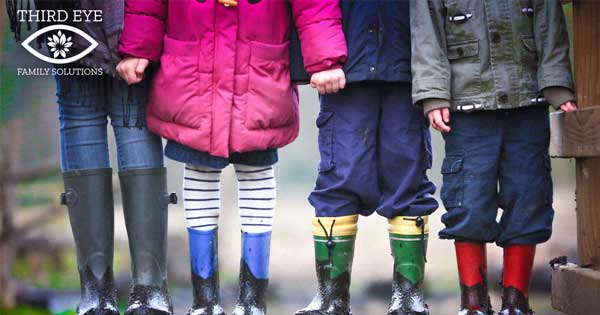Attachment Parenting is something that most parents have heard of these days. Images of babies in slings and carriers, co-sleeping, and breastfeeding are the most common things we think of when we hear the term. These are critical elements of Attachment Parenting, but they are not the only ones! Web MD lists the eight principle values of Attachment Parenting, which include positive discipline and nurturing touch.
At its core, Attachment Parenting is about bonding with your child, creating a foundation of love and security from which they begin to explore the world. The strong bonds formed allow children to feel safe in their knowledge that the primary caregiver will always love them and be there for support. Other elements of Positive Parenting discussed in previous blog posts, such as using Time Ins and creating teamwork in families all contribute to this foundation.
Most books and articles on Attachment Parenting focus on the lives of infants and toddlers. It is critical to form healthy attachments with babies, as it is needed for their mental, emotional and even physical development. However, you can start using the principles of attachment parenting at any age. The following is a look at some highlights of ways Attachment Parenting can be utilized through different stages of development.
Infants:
Babies spend approximately 9 months cocooned in the womb in a safe, warm place, free from outside interference. When born, infants seek ways to recreate this comfort. This is why Attachment Parenting for infants includes wearing your baby, safe co-sleeping, and breastfeeding.
All of these activities keep baby close to your body’s warmth and allow them to hear and feel your heartbeat. Swaddling is another way to keep very young babies feeling safe, though it is more effective when combined with things like co-sleeping. It is also critical to respond to your baby’s cries. When we do so, we teach them that they are safe and that we are there. When baby is already close to you, it is easier to respond quickly when they are young. Even if you are unable to breastfeed, you can bottle feed with connection and reinforce these bonds!
Toddlers (1-3):
Many toddlers will continue to want to be worn, and there are great carrier options for wearing older children! It is becoming more and more common for babies to continue nursing through this time as well.
Breastfeeding in older children not only continues to provide nutrition but remains an effective way to help regulate emotions and give the child a safe space in your lap. Sleeping with toddlers can be tricky – in some families this works well, and in others children need to be transitioned to their own sleeping space during this time. Differences in temperament also dictate these decisions – Dr. Jen had one child who co-slept until he was 5, and another who needed his own space by 18 months.
Beyond these practices, however, this is the age during which we start to use positive discipline. Use mistakes, hard moments, and difficult situations to name emotions and problem solve. Even when you are the only one talking, your child is learning. Saying, “Wow that was frustrating! Let’s see how else we could do that,” begins to teach the child to identify how they are feeling and to find solutions to their frustrations.
Young children (3-5):
Positive discipline is critical during this stage. Working out problems with our children during this time can be time-consuming, but you are setting the stage for them to be able to solve many problems on their own later on. Children in this age group are able to help more with problem solving.
Asking, “How should we handle this?,” can give them a chance to come up with their own solutions. Talking through options gives them tools to see possible outcomes. We can, of course, continue to hug and cuddle with children in this age group, while teaching them to set boundaries with their own bodies. Respecting your child’s emotions is also important during this (and every) stage.
At this age, a child can learn that their fears will be dismissed, or they can learn that you will help them navigate them. Simply validating how a child feels in this age group honors them and their experience.
Older children (6-12):
Many of the ways we parent for attachment are invalid by the time we reach this age group. Most are too big to be worn, want to sleep in their own rooms, and have outgrown breastfeeding a long time ago!
Positive discipline continues to be the most important attachment parenting tool at this stage, and by now you can often ask, “What’s up?,” when a problem occurs, and allow them to do most of the work. Your child’s personality will dictate the level of physical touch they want or will accept, with some children continuing to love hugs and cuddles and others wanting to keep their distance.
Routines that open up communication are also important. Having a few moments together every day without distractions allows your child to communicate with you. Even a simple, “What were the best and worst parts of your day?,” can be enough to get them talking, especially if they know that you will not judge them for what they say.
Teens (13-18):
Can you use attachment parenting with teens? Absolutely! Whether you have been parenting this way your whole life, or are just implementing these practices now, you can create connected relationships with your teenagers. Saying I love you in little ways each day reminds your teen that they are important to you. Listening to them talk about the things that excite them (yes, even the video game that you really don’t care about!) gives value to their interest.
Offering advice without judgement, and giving them the freedom to take it or not, lets them know that you are there when needed. Stay away from parenting that becomes oppressive – yes, teens need rules and boundaries, but they don’t need to feel as if their lives are being controlled by a parent. Where can you allow for freedom, even if that freedom means making mistakes?
And please, HUG YOUR TEEN! Dr. Jen gets two hugs a day from her 18-year-old, and she doesn’t usually initiate them. Becoming an adult can be scary for many teens, and they need physical reassurance just as much as they did when they were two!
This is, of course, a concise list of ways that attachment parenting can be use. We would love to hear your stories of the ways you created and maintain healthy attachment with your children! It’s also important to know that attachment can be healed or created later in life. Using play therapy and connection, we can help you if your child has experienced attachment issues. Please reach out if you need support, we offer Free Consultations to discuss your unique needs.


If you want to use the photo it would also be good to check with the artist beforehand in case it is subject to copyright. Best wishes. Aaren Reggis Sela
Hi Aaren – is this a photo of yours, or are you expressing a general concern?
Really informative blog article. Really thank you! Cool. Morganica Town Demeyer